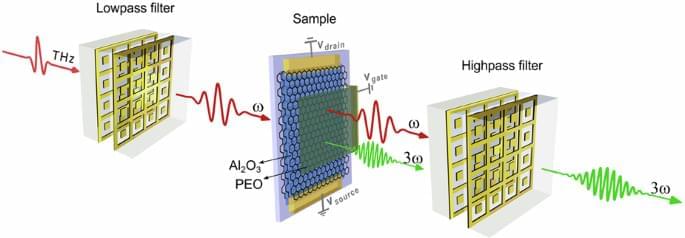The experimental configuration is shown schematically in Fig. 1. Sensitive detection of the THG signal requires the use of a lowpass filter (LPF), reducing the spectral width of the pump pulse and eliminating any residual pump at the third harmonic frequency. After the generation of the THG inside the graphene-based sample, a highpass filter (HPF) is used to limit the incident pump reaching the detection scheme. Although the HPF used in our experiment does not completely eliminate the pump, it still reduces the pump-induced noise at the third harmonic frequency to a value close to the noise floor. This technique relying on a HPF significantly increases the sensitivity of time-resolved detection to monitor the creation of new spectral components24,29. The general design of these filters are described in previous work31 and their spectral transmission properties are shown in Section 2 of the Supplementary Information. In brief, the LPF transmits multicycle THz pump pulse centered at the frequency, ω = 0.8 THz, and strongly attenuates (∼ 50 dB) spectral components beyond 1.5 THz. The HPF attenuates the pump pulse by 30 dB while transmitting the third harmonic at 3ω
We investigate six nonlinear samples consisting of stacked graphene sheets, from 1 to 15 layers, allowing us to vary the nonlinear interaction length. Figure 2a shows the spectrum of the THz pulse (blue line) transmitted through the LPF and used as the pump at the fundamental frequency ω. This graph only contains spectral measurements collected with the 1-, 3-, and 6-layer graphene samples (purple, green and red lines, respectively) for enhanced clarity of the display. A distinct THG spectral peak at 3ω = 2.4 THz can be observed with an intensity increasing roughly quadratically with the number of graphene layers (see Sections 1 and 3 in the Supplementary Information). The HPF, which role is to decrease the residual pump, allows the noise level at frequencies beyond 1.5 THz to settle close to the noise floor (grey shaded area), enabling sensitive monitoring of the nonlinear effects. Figure 2b shows the time-resolved multicycle pump pulse (blue line) with a peak amplitude of 32 kV/cm.









Leave a reply